Abstract
China is the world’s leading producer of molybdenum–copper concentrates, an industry noted for its high energy demand and considerable environmental burdens. This study applies a cradle-to-gate life cycle assessment to the production of molybdenum–copper concentrate in the Lesser Khingan Mountains, utilizing the ReCiPe 2016 midpoint method coupled with Monte Carlo uncertainty analysis. The results indicate that human carcinogenic toxicity represents the greatest environmental risk, followed by marine and freshwater ecotoxicity. Contribution analysis reveals that the grinding stage is the dominant impact driver—particularly due to hexavalent chromium emissions—affecting carcinogenic risk, climate change potential, and fossil resource depletion. Scenario testing demonstrates that upgrading grinding technology, enhancing electricity efficiency, and substituting conventional energy with renewable sources can markedly mitigate these impacts. However, because of implementation barriers, such as high capital costs, retrofit downtime, and uncertainties in the supply chain, a pilot phase is necessary before deployment at full scale. Quantitatively, the production of one tonne of molybdenum–copper concentrate corresponds to 0.05 DALYs of human health damage, 1.11 × 10−4 species.year of ecological loss, and USD 3488.82 of resource depletion. These results provide constructive references for the sustainable development of the mining industry and contribute to achieving China’s dual carbon targets through energy transformation and low-carbon technological innovation.
1. Introduction
Molybdenum ore, as an important strategic metal resource, plays an indispensable role in the global economic industrialization process. Due to its high melting point, high strength, and excellent corrosion resistance, molybdenum is widely used in aerospace, defense, energy, and steel alloy reinforcement. In steel and cast-iron applications, molybdenum has few viable substitutes [,,]. Particularly in high-temperature alloys, the addition of molybdenum significantly enhances material performance, making it a crucial raw material for aerospace engines and power plant components []. Furthermore, molybdenum ore is a key component in many industrial catalysts and lubricants, widely used in applications such as diesel engine exhaust catalytic treatment [].
According to reports [], the global molybdenum metal production in 2024 was approximately 260,000 tonnes, with China producing around 110,000 tonnes, accounting for 42.31% of the total global output. China, Peru, Chile, the United States, and Mexico collectively contributed 90% of the world’s total production. Among these top five producing countries, only China and the United States extract molybdenum from both primary molybdenum ores and copper ores as a by-product, while the other countries produce molybdenum solely as a by-product of copper mining.
The production of molybdenum ore faces numerous environmental challenges, primarily due to its common coexistence with other metals, which results in the generation of large amounts of waste during mining, beneficiation, and smelting processes []. Meanwhile, as the predominant mining method, open-pit mining, though efficient and cost effective, produces dust, noise, and exhaust emissions during blasting, transportation, and waste dumping. These not only disrupt surrounding ecosystems but also lead to soil erosion and permanent landscape alterations, causing long-term adverse effects on biodiversity []. In the beneficiation process, physical and chemical methods are used to separate molybdenum minerals from gangue, which improves resource utilization efficiency. However, grinding and flotation require large amounts of water and chemical reagents, and if wastewater is not properly treated, it can cause severe pollution to water bodies and soil. Additionally, the acidic or alkaline wastewater, solid waste, and hazardous gases generated during beneficiation require strict environmental monitoring and treatment [,]. Statistics show that China generates approximately 36 million tonnes of molybdenum tailings annually. These tailings not only require vast landfill areas but also pose a significant environmental risk, as snowmelt or rainwater infiltration can leach dissolved heavy metals and other toxic substances into surface water bodies, leading to soil and water pollution []. Moreover, due to their high potential energy, tailings dams present a serious safety hazard, and any occurrence of debris flows or dam instability could severely threaten downstream communities and critical infrastructure []. In recent years, with the advancement of green mining initiatives and growing environmental awareness, increasing research has focused on the environmental impacts of molybdenum mining and beneficiation as well as mitigation measures. For instance, improvements in beneficiation processes, optimization of reagent formulations, and the introduction of efficient wastewater treatment systems have contributed to reducing resource consumption and pollutant emissions to some extent [,]. However, most existing studies on the environmental impact of open-pit molybdenum mining and beneficiation focus on individual stages, lacking a systematic life cycle perspective to comprehensively assess their environmental effects.
Life cycle assessment (LCA) is a comprehensive, cradle-to-grave environmental analysis methodology that quantitatively measures the impacts of products, processes, or activities on the environment []. Thanks to its systematic framework and data-driven approach, LCA has been extensively adopted across various sectors, including resource extraction operations, construction engineering projects, and agricultural production practices [,,].
In the mining industry, Tao et al. [,,] analyzed the life cycle environmental impacts of lead–zinc concentrate production, coal mining at different scales, and electrolytic manganese metal production in China. Their study on lead–zinc mining found that the main environmental impacts stem from tailings pollution, chemical production, and electricity consumption. Studies examining coal mining at varying scales have shown that, as mining operations expand, the degree of metal pollution during the production stage tends to increase significantly. In parallel, investigations into the environmental footprint of electrolytic manganese metal manufacturing have highlighted human carcinogenic toxicity as the most critical impact category. This is largely attributed to high-impact processes such as electricity generation, mining operations, and the use of ammonia. Additionally, Turkbay et al. [] carried out an LCA focused on Turkey’s boron mining sector, revealing that the refining stage posed the greatest environmental burden. The most substantial contributors to this impact were identified as sulfuric acid, steam, and hydrogen peroxide usage, with sodium perborate production standing out for its particularly high environmental load. Rachid et al. [] evaluated the environmental impact of phosphate mining in Morocco and discovered that diesel combustion was the primary pollution source. The use of renewable energy and wind power could significantly reduce the global warming potential, and electrification and selective catalytic reduction processes were also effective in reducing environmental impacts. However, comprehensive life cycle assessments of environmental impacts in molybdenum mining remain scarce.
Therefore, this study adopts the LCA method to systematically analyze the environmental impacts of the entire life cycle of the open-pit molybdenum mining and beneficiation process. The research focuses on the entire process, from ore extraction and transportation to beneficiation and tailings dam management, quantifying resource consumption, emissions, and their potential environmental impacts at each stage. Additionally, it explores the differences in environmental impacts across various mining and beneficiation processes, identifies pollution hotspots, and suggests improvement directions. The aim of this study is to reveal the environmental burdens of the open-pit molybdenum mining process, providing data support and theoretical foundations for green mining initiatives and process optimization and promoting the sustainable development and utilization of molybdenum resources.
2. Materials and Methods
2.1. Object of Research
Luming Mining Co., Ltd.—one of China’s largest single molybdenum producers—is located at 128°32′ E, 47°21′ N in the Luming Forestry Bureau of Yichun City, China, within the Lesser Khingan-Zhangguangcailing metallogenic belt (see Figure 1). This north–south-trending Mesozoic magmatic arc, on the eastern margin of the Songliao Basin, is defined by Early–Middle Jurassic granites and Late Triassic–Early Jurassic volcanics, bounded to the east by the Jiayin-Yilan-Mudanjiang Fault and to the north by the Heihe-Nenjiang Fault. Since commencing operations in 2013, the open-pit mine has processed approximately 15 million tonnes of ore annually, yielding 22,500 tonnes of molybdenum–copper concentrate each year. The deposit’s primary metal-bearing minerals are molybdenite (MoS2), powellite (CaMoO4), pyrite (FeS2), azurite (Cu3(CO3)2(OH)2), and chalcopyrite (CuFeS2). Host rocks comprise quartz–monzonite and diorite, hydrothermal breccia, porphyritic granite, and, in the western sector of the mine, potassium–feldspar granite. Molybdenite remains enriched within quartz–potassium–feldspar alteration zones along the ore-body margins. Ore grades of Mo typically range from 0.03% to 0.11%. The mine’s principal product is molybdenum concentrate (≈50% Mo), with copper concentrate (≈20% Cu) as a by-product; the annual value ratio of molybdenum to copper concentrates is approximately 5:1.
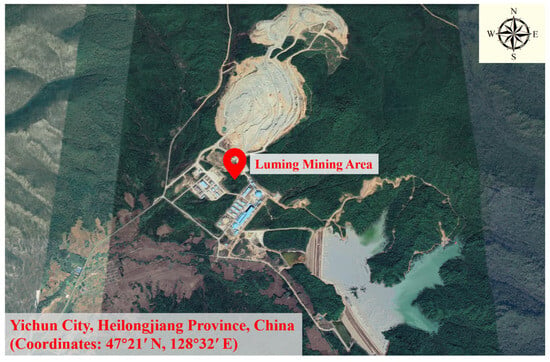
Figure 1.
Geographical location of Luming mining area.
The mine adopts open-pit mining methods, utilizing modern processes such as drilling, blasting, loading, transportation, and waste dumping to extract ore. Advanced equipment and technologies, including gyratory crushers, SAG mills, ball mills, and efficient flotation techniques, are employed to achieve efficient ore crushing, grinding, and mineral separation, thereby significantly improving resource utilization, reducing energy consumption, and lowering pollutant emissions. Furthermore, the extreme temperatures and long frozen soil periods in the Lesser Khingan Mountains region pose challenges for both mining operations and environmental management, making it a crucial case for life cycle environmental impact assessment and the exploration of sustainable mining strategies. According to statistics, 1 tonne of raw ore transforms into approximately 0.002 tonnes of concentrate, 0.99 tonnes are sent to the waste rock dump, and 0.008 tonnes are lost.
Although our initial intent was to evaluate the life cycle environmental impacts of molybdenum concentrate production alone, the case mine produces a combined molybdenum–copper concentrate, with copper concentrate treated as a by-product. Accordingly, this study adopts a joint-production LCA framework for the molybdenum–copper concentrate, allocating environmental burdens between the primary product (molybdenum) and the co-product (copper) based on their relative economic values. This approach ensures that the resulting impact assessment accurately reflects the integrated nature of the mine’s processing operations.
2.2. Functional Unit and System Boundary
In this life cycle assessment, we designate the production of one tonne of molybdenum–copper concentrate as the functional unit, thereby creating a uniform basis for quantifying and comparing environmental impacts throughout all relevant stages. The cradle-to-gate boundary adopted here ensures that every activity up to the point at which the concentrate leaves the processing facility is captured while intentionally excluding downstream phases, such as product use and end-of-life disposal.
Under this framework, the system is divided into two principal segments. The first, the mining phase, involves a suite of operations beginning with site preparation and drilling, followed by blasting to fragment the ore body. Fragmented material is then loaded onto haul trucks and transported to waste rock dumps or to the processing plant feed stock area. At each step, energy inputs (mainly diesel fuel and electricity) and emissions are tracked. The second segment, the beneficiation phase, encompasses the physical and chemical treatments required to concentrate molybdenum and copper minerals. Initial comminution is conducted through crushing and grinding to reduce particle size, after which flotation reagents are introduced to separate valuable minerals from gangue. Tailings are managed in an engineered impoundment, and clear water decanted from the impoundment is either recycled back into the plant or discharged following sedimentation treatment. All material and energy flows, including electricity consumption, chemical usage, and water withdrawal, are quantified and attributed to the functional unit. Beyond these process-centric activities, our boundary explicitly incorporates the living service area that supports on-site personnel. This includes the daily provision of utilities, transportation for employees between accommodation and the plant, and related waste management.
To maintain analytical clarity, we expressly exclude the production, maintenance, and eventual disposal of mining and processing equipment, as capital goods burdens are amortized over the entire mine lifetime and contribute negligibly on a per tonne of concentrate basis. Moreover, detailed data on these stages are often unavailable or inconsistent for specific machinery. By clearly defining these inclusions and exclusions, this study delivers a rigorous, transparent, and comparable assessment of the environmental footprint associated with generating one tonne of molybdenum–copper concentrate. The system boundary is shown in Figure 2.
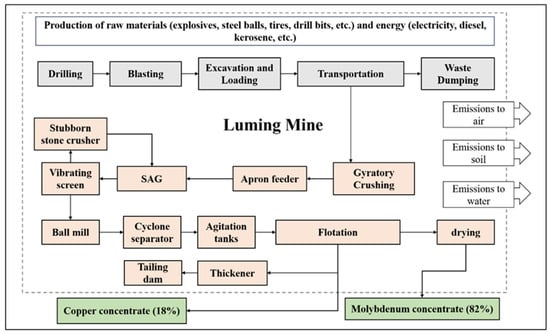
Figure 2.
The system boundary of the mining and beneficiation process for one tonne of molybdenum–copper concentrate.
2.3. Method and Life Cycle Inventory
This study uses SimaPro 9.0.0.49 software to quantitatively analyze the environmental impact of the open-pit molybdenum mining and beneficiation process. SimaPro is one of the most advanced life cycle assessment software tools globally and is widely used in environmental evaluation research. The software integrates databases such as Ecoinvent, Input–Output, and ELCD []. The environmental impacts are classified and normalized at both the midpoint and endpoint levels using the ReCiPe 2016 method, ensuring that the results are internationally comparable []. ReCiPe 2016 is one of the most commonly used methods in life cycle assessment, which divides environmental impacts into 18 midpoint impact categories and 3 endpoint impact categories, as shown in Figure 3. In addition, this study conducts uncertainty analysis based on the Monte Carlo method. At a 95% confidence level, 1000 simulations are run via computer to assess the uncertainty of the evaluation results. This analysis method effectively reduces the impact of input data variability on the research conclusions, ensuring the reliability and robustness of the results.
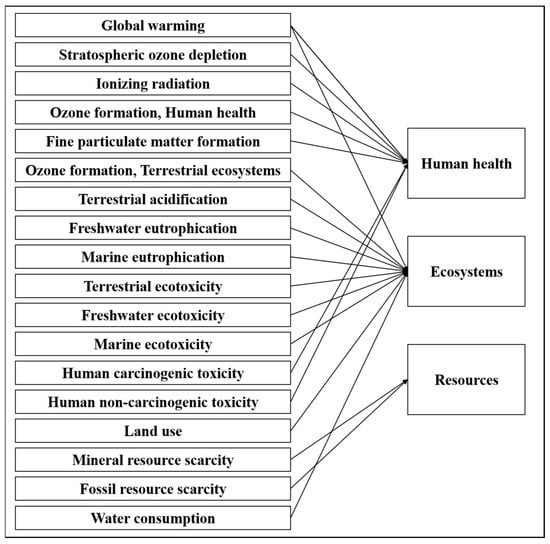
Figure 3.
Environmental impacts in the ReCiPe 2016 method.
Primary on-site data were collected from Luming Mining Co., Ltd. between January and December 2024; only data on emissions to water were obtained from the Ecoinvent database. Since unavoidable errors exist in the data collection process, the data inevitably fluctuate within a certain range. To quantify these uncertainties, the square of the geometric standard deviation (GSD2), corresponding to a 95% confidence interval, is employed as the statistical measure []. The resulting life cycle inventory data are summarized in Table 1.

Table 1.
Life cycle inventory.
3. Results
3.1. Midpoint Results
Table 2 displays the midpoint results from the life cycle impact assessment (LCIA), covering 18 different environmental impact categories, as calculated using the ReCiPe 2016 methodology. For instance, within the global warming category, the production process including both mining and beneficiation for one tonne of molybdenum–copper concentrate contributes an equivalent impact of 28,679.62 kg of CO2. Notably, this figure does not represent CO2 emissions alone; it also encompasses other greenhouse gases, such as methane (CH4), perfluorocarbons (PFCs), and water vapor (H2O). In this context, carbon dioxide is used as the reference gas, and emissions of the other greenhouse gases are converted into CO2 equivalents using standardized characterization factors. As an example, CH4 has a characterization factor of 25, meaning that releasing 1 kg of methane into the atmosphere has the same warming potential as emitting 25 kg of carbon dioxide. This conversion principle is consistently applied across all other impact categories as well. Significantly, Table 2 indicates that terrestrial ecotoxicity reaches 20,995.42 kg 1,4-DCB eq, driven primarily by trace emissions of heavy metals (Cu, Cr, Ni) during grinding, flotation, and tailings handling. Although released in minute quantities, these metals possess high toxicity characterization factors under ReCiPe 2016, leading to a large absolute impact score. However, when normalized against global reference loads, the relative contribution is minimal, reflecting a low normalized value despite the high characterization result. This suggests that, while metal releases warrant mitigation at the site level, their influence on ecosystem toxicity at the regional or global scale remains limited.

Table 2.
LCIA midpoint results (based on functional units).
To address the inherent uncertainties in the input data, a Monte Carlo simulation was used to perform uncertainty analysis for each midpoint result. A 95% confidence level was set by employing the squared geometric standard deviation (GSD2) as the uncertainty metric. Taking the global warming impact as an example, the estimated value of 28,679.62 kg CO2 eq was associated with a GSD2 of 1.35, resulting in a 95% confidence interval ranging from 21,244.16 to 38,717.49 kg CO2 eq. This same analytical approach was applied to all other categories included in the LCIA.
3.2. Standardized Midpoint Results
In order to identify the impact category with the greatest environmental effect, the midpoint results were normalized. Figure 4 shows the normalized midpoint results, with data having normalized values below 3 not displayed. According to Figure 4, human carcinogenic toxicity is the most prominent among the 18 impact categories, with a normalized value as high as 98.5, followed by marine ecotoxicity and freshwater ecotoxicity in second and third place, respectively. At the same time, it can be observed that the normalized value for climate change is 3.6. Some impact categories have normalized values approaching zero, including ionizing radiation, marine eutrophication, land occupation, mineral resource scarcity, and water resource consumption.
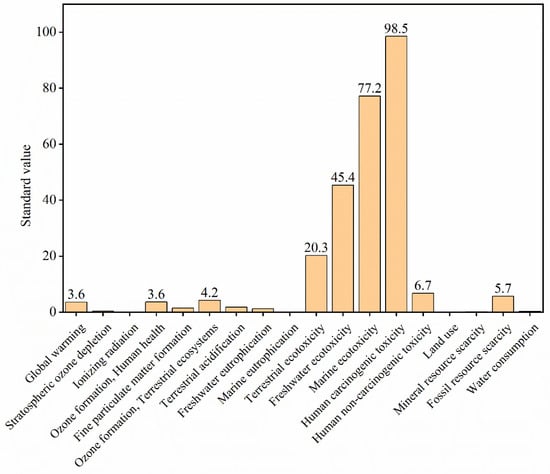
Figure 4.
Standardization results of midpoint.
3.3. Identification of Key Factors
To obtain practical research results and propose reasonable improvement measures to reduce environmental burdens, the production process of molybdenum–copper concentrate was divided into various stages to further examine the environmental impact of each stage. Figure 5 shows the proportions of 18 midpoint impact categories for the main stages in the production of one tonne of molybdenum–copper concentrate, with data for proportions below 15% not displayed. In the case of human carcinogenic toxicity, 82% of the impact originates from the grinding stage; notably, this is attributable to the upstream production of the steel grinding media used rather than to direct emissions during the grinding process; for marine ecotoxicity and freshwater ecotoxicity, the environmental impacts mainly stem from direct emissions, accounting for 74% and 89%, respectively. Overall, for 12 impact categories, more than 50% of the impact is attributable to the grinding stage, which should, therefore, be the focus of subsequent efforts.
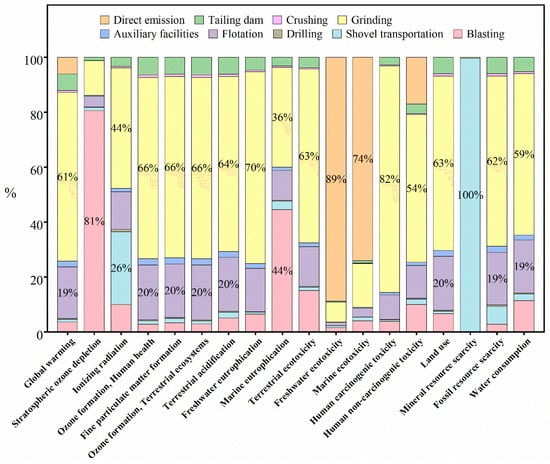
Figure 5.
Midpoint results in each process.
In the LCIA midpoint results, the top three impact categories known to have negative environmental effects are human carcinogenic toxicity, marine ecotoxicity, and freshwater ecotoxicity. Considering the research value of fossil resource scarcity and the globally debated issue of global warming [], these two categories were also included. A key substance identification was then performed for these five categories, with substances contributing less than 1% truncated. The final results are shown in Figure 6. The key contributing substances are chromium (Cr (VI)) and copper. Cr (VI) is predominantly generated during the grinding and flotation stages, likely because these processes consume large amounts of coal-fired electricity, whereas copper emissions mainly arise from on-site direct discharge activities. Moreover, chromium contributes as much as 99% to human carcinogenic toxicity, while copper accounts for 75% of marine ecotoxicity. Carbon dioxide is the primary substance in the global warming category, contributing up to 77%.

Figure 6.
Identification of key factors.
3.4. LCIA Endpoint Results
The analysis of the LCIA midpoint results primarily reveals the quantitative values of various environmental impact indicators during production. However, due to differences in units and scales among these indicators, it is difficult to directly compare their overall contributions to the environment. Therefore, endpoint analysis is further conducted to supplement and integrate this information, providing a more intuitive overall environmental impact assessment. The LCIA endpoint damage results are shown in Table 3. The three endpoint damage categories encompass the ultimate environmental repercussions across three major domains: human health deterioration, ecosystem impairment, and resource depletion. These impacts are quantified respectively in disability adjusted life years (DALYs), species lost per year (species.yr), and their economic valuation in US dollars, thereby providing a clear measure of the severity of each damage theme. Table 3 shows that the mining and beneficiation process for one tonne of molybdenum–copper concentrate results in 0.05 DALYs of damage to human health, 1.11 × 10−4 species.yr of damage to the ecosystem, and a resource depletion value of 3488.82 USD. The 0.05 DALY per tonne figure implies that producing one tonne of molybdenum–copper concentrate results in a loss of 0.05 years of healthy life across the exposed population of workers and nearby residents; this metric captures both morbidity and premature mortality due to pollutant exposures.

Table 3.
LCIA endpoint results (based on each functional unit).
3.5. Sensitivity Analysis
Sensitivity analysis plays a critical role in life cycle assessment. It allows for the quantitative evaluation of the impact of uncertainties and variations in key input parameters and production processes on the overall assessment results, ensuring the robustness of the evaluation. By setting variation coefficients for input and output values, it is possible to observe the extent to which parameter fluctuations affect the final environmental impact indicators and identify the key variables that play a decisive role in the evaluation results. Based on the previous research, a sensitivity analysis was conducted by changing the key process input values by 5%, focusing on the grinding, direct emissions, flotation, blasting, and tailings dam stages. In this study, we defined a critical sensitivity threshold of 3%, with changes above this level considered critical, those between 2% and 3% moderate, and those below 2% minor. The results are shown in Figure 7. From the results, it can be clearly seen that the grinding and direct emission stages are more sensitive to the major environmental impact categories. The grinding stage exhibits a sensitivity greater than 3% in global warming, human carcinogenic toxicity, and fossil resource scarcity. The direct emission stage shows a sensitivity of around 4% in marine ecotoxicity and freshwater ecotoxicity. Therefore, to reduce the negative environmental impacts of molybdenum–copper concentrate production, a significant optimization approach would be to focus on improving the efficiency of the grinding and direct emission stages.

Figure 7.
Sensitivity analysis.
4. Discussion
The research results show that the grinding stage is the primary source of environmental impacts in the open-pit molybdenum–copper concentrate mining and beneficiation process, particularly in categories such as human carcinogenic toxicity, global warming, and fossil resource scarcity, where its contribution is most significant. This phenomenon is primarily attributed to the high energy consumption of the grinding stage, with electricity usage accounting for more than 50% of the total energy consumption in the entire production process. Therefore, optimizing the grinding stage is a key direction for reducing the environmental burden.
4.1. Thoughts on Upgrading the Power Structure
The high electricity consumption in the grinding stage is not only a production technology issue but also reflects the limitations of China’s coal-based energy structure []. According to data from the 2024 China Statistical Yearbook, the total primary energy production in China in 2023 was 483 million tonnes of standard coal, with raw coal accounting for the largest share at 66.6%, followed by crude oil at 6.2%, natural gas at 6.0%, and primary electricity and other energy sources at 21.2%. This demonstrates an energy structure characterized by “more coal, less oil, and limited natural gas”. Additionally, in 2022, China’s total power generation reached 8.69 × 1012 kWh, with thermal power accounting for 65.96% of total generation; hydroelectric power accounting for 15.55%; and wind, solar, and nuclear power collectively making up less than 10%. In light of the challenges associated with coal-fired power generation and its contribution to climate change, China announced at the 75th United Nations General Assembly in 2020 its goals to reach peak carbon emissions by 2030 and achieve carbon neutrality by 2060. China has actively promoted the transformation and upgrading of its energy structure, and its green, low-carbon electricity development is continuously advancing []. Therefore, it is crucial to further explore how to effectively reduce energy consumption and environmental load by replacing traditional high-carbon energy with green, low-carbon electricity.
To this end, all electricity sources in the life cycle inventory, originally based on a coal-fired power mix, were, respectively, replaced with hydropower, wind power, and solar power. We then performed LCA analyses for each scenario and conducted a comprehensive comparison of the results. Figure 8 shows a comparison of the midpoint environmental impacts of thermal power generation and three types of low-carbon energy generation. Overall, thermal power generation exhibits much higher midpoint impact values across all environmental categories, far exceeding those of hydropower, wind power, and solar power. To quantify the specific improvements achieved by the three low-carbon energy scenarios in the categories of human health, ecosystem quality, and resource availability, we performed an endpoint LCA analysis. As shown in Table 4, all low-carbon scenarios deliver endpoint improvements exceeding 80%, with solar power yielding the most pronounced reduction, approaching nearly 100%.
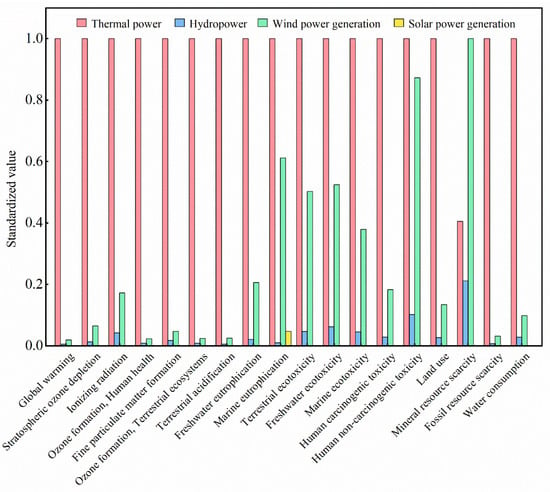
Figure 8.
Comparison of environmental impact under different power generation structures.

Table 4.
Comparison of clean energy and thermal power generation at the endpoint level.
The Luming mine is located in Heilongjiang Province, where the regional power mix comprises 60% coal-fired generation, 26% wind power, and 14% hydropower plus solar power. Given the region’s abundant wind resources, effectively increasing wind-power capacity is clearly the optimal strategy for achieving cleaner production. We conducted a detailed simulation of varying wind-power shares, with the results presented in Figure 9. As wind-power proportion increases, endpoint impacts in the categories of human health, ecosystem quality, and resource depletion progressively decline. Under current circumstances, if Heilongjiang Province were to raise its wind-power share to 40%, the endpoint impacts of molybdenum–copper concentrate production would be reduced to 0.0321 DALY for human health, 0.6826 species.year for ecosystem quality, and USD 2273 for resource depletion.
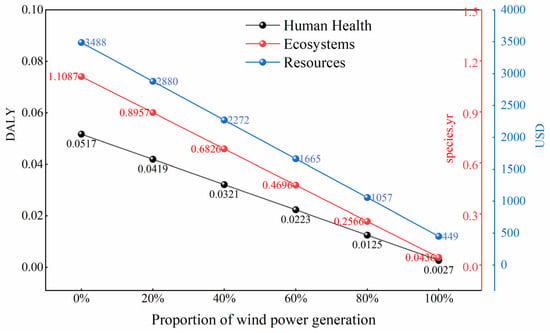
Figure 9.
Relationship between the environmental impacts of molybdenum–copper concentrate production and the share of wind power.
From a life cycle perspective, while hydro-, wind, and solar power have very low carbon emissions during their operation stages, their entire industrial chains still present non-negligible environmental impacts. Taking wind power as an example, wind power appears to have minimal environmental impact during its operation stage. In fact, compared to coal-fired power, wind power significantly reduces the emission of atmospheric pollutants, with reductions of 80.38%, 57.31%, and 30.91% in SO2, NOx, and PM10 emissions, respectively []. The aforementioned studies indicate that continuously increasing the installed capacity of low-carbon energy and its integration into the grid can significantly reduce the environmental impacts caused by molybdenum–copper concentrate production. Currently, about 65% of China’s wind capacity is clustered in North China, Northeast China, and along the eastern coast, creating a “north-heavy, east-light, coastal-advantage” pattern []. Therefore, when optimizing the power structure and promoting low-carbon energy generation, it is essential to not only develop wind but also fully consider the specific conditions of different regions. Regional policies should be tailored to local conditions, leveraging the advantages of existing wind power while promoting the development and supplementation of renewable energy in other regions [].
4.2. Thoughts on Improving Mining Production Industry
However, it will take some time for China to fully replace thermal power generation with clean energy. In the short-term, selecting appropriate mining equipment for production seems to effectively reduce energy consumption []. Throughout the process from mining to mineral processing, the investment and operating costs of the beneficiation plant grinding production account for about half of the total investment and costs, mainly due to the energy consumption in the grinding process and the consumption of grinding media []. Therefore, choosing the right grinding equipment and grinding media is crucial for controlling operational costs, reducing energy and material consumption, and minimizing environmental pollution in mining enterprises. In the production of molybdenum–copper concentrate, the commonly used grinding equipment includes ball mills and vertical mills. We conducted scenario analyses in which, while keeping all other production conditions constant, (a) the ball mill was replaced with a vertical mill, and (b) the steel grinding media were substituted with ceramic balls for comparison. A life cycle assessment method was used to compare the environmental impact of processing one tonne of molybdenum–copper ore with a ball mill and a vertical mill. The analysis results show that, for the overall environmental impact categories, the vertical mill reduces about 30% of the environmental impact compared to the ball mill. This is particularly evident in marine ecotoxicity, human carcinogenic toxicity, freshwater ecotoxicity, terrestrial ecotoxicity, and human non-carcinogenic toxicity, as shown in Figure 10a. In addition to the properties of the ore itself and the selection of grinding equipment, the choice of grinding media also plays a significant role in determining the overall environmental impact of the grinding process []. Steel balls are the most common grinding media, and the grinding process requires the consumption of large amounts of steel balls. Reducing wear and consumption of steel balls can significantly reduce the environmental burden. In recent years, research on grinding media has been continuously deepening. For instance, Liao et al. [] analyzed the grinding and flotation behaviors of chalcopyrite and pyrite and found that, under the same grinding fineness conditions, nano-ceramic balls reduced energy consumption by more than 60% compared to steel balls. A life cycle assessment method was used to compare the environmental impacts of processing one tonne of molybdenum–copper ore using steel balls and nano-ceramic balls. The results indicated that the overall environmental impact of nano-ceramic balls was 80% lower than that of steel balls, with the major environmental impact categories shown in Figure 10b. Due to their excellent properties, such as high strength, wear resistance, and low energy consumption, nano-ceramic balls can be used as a substitute for steel balls to reduce energy consumption in the grinding process. In conclusion, developing high-performance, low-energy grinding media is an effective measure to reduce the environmental impact of the grinding process in the beneficiation stage.
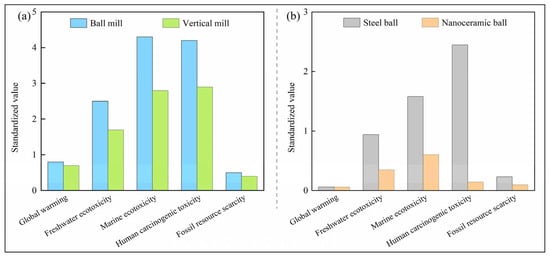
Figure 10.
Comparison of main environmental impact categories: (a) Comparison between ball mill and vertical mill; (b) Comparison between steel balls and nano-ceramic balls.
Nevertheless, several key implementation challenges must be addressed before full-scale deployment: high upfront investment and long payback periods for vertical mills and nano-ceramic balls; the need for extended downtime and process reconfiguration to retrofit existing mills, which may disrupt production continuity; immature supply chains for nano-ceramic media, leading to uncertainty in spare parts availability, cost, and lead time; and lengthy approval processes for green financing or subsidies, making it difficult to fully offset capital expenditures in the short-term. To address these challenges in the context of the Luming mine’s current configuration, we recommend a pilot phase in which one ball mill is replaced with a vertical mill and the other is trialed with nano-ceramic grinding balls while retaining the SAG mill as a control. Key performance indicators, such as power consumption, throughput, and media wear rate, should be monitored and compared to quantify energy savings, emission reductions, and economic benefits. Based on the pilot results, a phased rollout plan can be developed, supported by negotiations with equipment suppliers to secure green loans or government subsidies to share initial costs. Concurrently, establishing an equipment performance monitoring and maintenance protocol will ensure operational reliability of the new technologies, thereby enabling a technically feasible and economically viable, low-carbon, high-efficiency upgrade of the grinding circuit.
By combining technological improvements with energy transformation, it is possible to significantly reduce resource consumption and pollutant emissions in the grinding stage while also providing a solid foundation for the sustainable development of China’s molybdenum mining industry. Promoting the construction of green mines is not only a current necessity to address environmental challenges but also an essential path toward achieving high-quality development in the mining industry.
5. Conclusions
In summary, as economic growth drives up demand for molybdenum–copper concentrate, the environmental and health burdens of its extraction and processing have become increasingly severe. Applying a cradle-to-gate LCA at Luming Mine, we quantified midpoint impacts and normalized the results, revealing that human carcinogenic toxicity, marine ecotoxicity, and freshwater ecotoxicity are the most critical categories. Further analysis identified the grinding phase as the dominant contributor to impacts such as carcinogenic risk, climate change, and depletion of fossil resources. At the endpoint level, producing one tonne of concentrate translates into about 0.05 DALY of human health damage, 1.11 × 10−4 species.yr of ecological loss, and roughly USD 3488.82 in resource depletion losses. Sensitivity testing showed that optimizing grinding operations and enhancing electricity usage efficiency can substantially mitigate these impacts and that shifting from conventional to cleaner energy sources offers additional environmental benefits. However, given high upfront costs, downtime for retrofits, and supply chain uncertainties, we recommend piloting one ball mill’s conversion to a vertical mill and using nano-ceramic media in another, with the SAG mill as a control, to guide a phased rollout. To help China meet its 2030 carbon-peak and 2060 carbon-neutrality goals, we recommend short-term measures such as adopting advanced grinding technologies (for example, vertical mills with nano-ceramic media) and longer-term strategies focused on accelerating renewable energy deployment and improving industrial energy efficiency.
Author Contributions
Formal analysis, W.X., Y.G. and C.Z.; Investigation, W.X.; Methodology, W.X., M.T. and X.Q.; Validation, W.X.; Writing—original draft, W.X., Y.G. and C.Z.; Writing—review and editing, Y.G., C.Z., M.T. and X.Q. All authors have read and agreed to the published version of the manuscript.
Funding
The research presented in this paper was funded by the National Natural Science Foundation of China (Grant No. 1207237).
Institutional Review Board Statement
Not applicable.
Informed Consent Statement
Not applicable.
Data Availability Statement
The raw data supporting the conclusions of this article will be made available by the authors on request.
Conflicts of Interest
Authors Wei Xia, Yanyan Geng, Chunlei Zhao were employed by the company Yichun Luming Mining Co., Ltd. All authors declare that the research was conducted in the absence of any commercial or financial relationships that could be construed as a potential conflict of interest.
Abbreviations
The following abbreviations are used in this manuscript:
| LCA | Life Cycle Assessment |
| LCIA | Life Cycle Impact Assessment |
| SAG | Semi-Autogenous Grinding |
References
- Lv, J.; Wang, Z.; Liang, T.; Ken, S.; Hideo, M. Enhancing the corrosion resistance of the 2205 duplex stainless steel bipolar plates in PEMFCs environment by surface enriched molybdenum. Results Phys. 2017, 7, 3459–3464. [Google Scholar] [CrossRef]
- Bogucki, R.; Pytel, S.M. Influence of molybdenum addition on mechanical properties of low carbon hsla-100 steel. Arch. Metall. Mater. 2014, 59, 859–864. [Google Scholar] [CrossRef]
- Jarosz, P. Preparation of steels and cast irons with the addition of molybdenum and vanadium. JOM 2013, 65, 1615–1621. [Google Scholar] [CrossRef]
- Li, M.; Zhang, X.; Cao, M.; Zhou, Z.; Rao, J.; Yi, S.; Zhang, Y.; Fu, J.; Chen, L.; Ding, S. Wear resistance of molybdenum disulfide-based coatings on titanium alloys: A review. J. Mater. Sci. 2024, 59, 6662–6684. [Google Scholar] [CrossRef]
- Shen, Y.; Jiang, P.; Wai, P.T.; Gu, Q.; Zhang, W. Recent progress in application of molybdenum-based catalysts for epoxidation of alkenes. Catalysts 2019, 9, 31. [Google Scholar] [CrossRef]
- Mineral Commodity Summaries 2025; U.S. Geological Survey: Reston, VA, USA, 2025; p. 212.
- Gao, S.; Cui, X.; Kang, S.; Ding, Y. Sustainable applications for utilizing molybdenum tailings in concrete. J. Clean. Prod. 2020, 266, 122020. [Google Scholar] [CrossRef]
- Zhang, L.; Wang, J.; Feng, Y. Life cycle assessment of opencast coal mine production: A case study in Yimin mining area in China. Environ. Sci. Pollut. Res. 2018, 25, 8475–8486. [Google Scholar] [CrossRef]
- Edraki, M.; Baumgartl, T.; Manlapig, E.; Bradshaw, D.; Franks, D.M.; Moran, C.J. Designing mine tailings for better environmental, social and economic outcomes: A review of alternative approaches. J. Clean. Prod. 2014, 84, 411–420. [Google Scholar] [CrossRef]
- Nordstrom, D.K.; Blowes, D.W.; Ptacek, C.J. Hydrogeochemistry and microbiology of mine drainage: An update. Appl. Geochem. 2015, 57, 3–16. [Google Scholar] [CrossRef]
- Gao, S.; Cui, X.; Zhang, S. Utilization of molybdenum tailings in concrete manufacturing: A review. Appl. Sci. 2020, 10, 138. [Google Scholar] [CrossRef]
- Islam, K.; Murakami, S. Global-scale impact analysis of mine tailings dam failures: 1915–2020. Glob. Environ. Chang. 2021, 70, 102361. [Google Scholar] [CrossRef]
- Wang, X.; Gao, Y.; Jiang, X.; Zhang, Q.; Liu, W. Analysis on the characteristics of water pollution caused by underground mining and research progress of treatment technology. Adv. Civ. Eng. 2021, 2021, 9984147. [Google Scholar] [CrossRef]
- Behera, S.K.; Mulaba-Bafubiandi, A.F. Microbes assisted mineral flotation a future prospective for mineral processing industries: A review. Miner. Process. Extr. Metall. Rev. 2017, 38, 96–105. [Google Scholar] [CrossRef]
- Olsson, J.A.; Miller, S.A.; Kneifel, J.D. A review of current practice for life cycle assessment of cement and concrete. Resour. Conserv. Recycl. 2024, 206, 107619. [Google Scholar] [CrossRef]
- Konare, Z.M.; Ajayi, D.D.; Ba, S.; Aremu, A.K. Application of life cycle sustainability assessment (LCSA) in the gold mining sector: A systematic review. Int. J. Life Cycle Assess. 2023, 28, 684–703. [Google Scholar] [CrossRef]
- Chau, C.K.; Leung, T.M.; Ng, W.Y. A review on life cycle assessment, life cycle energy assessment and life cycle carbon emissions assessment on buildings. Appl. Energy 2015, 143, 395–413. [Google Scholar] [CrossRef]
- Notarnicola, B.; Sala, S.; Anton, A.; McLaren, S.J.; Saouter, E.; Sonesson, U. The role of life cycle assessment in supporting sustainable agri-food systems: A review of the challenges. J. Clean. Prod. 2017, 140, 399–409. [Google Scholar] [CrossRef]
- Tao, M.; Zhang, X.; Wang, S.; Cao, W.; Jiang, Y. Life cycle assessment on lead-zinc ore mining and beneficiation in China. J. Clean. Prod. 2019, 237, 117833. [Google Scholar] [CrossRef]
- Tao, M.; Lu, D.; Shi, Y.; Liu, K.; Yan, D.; Memon, M.B. Life cycle assessment of coal mines of diverse scales over time in China. Sci. Total Environ. 2024, 912, 169236. [Google Scholar] [CrossRef]
- Tao, M.; Qiu, X.; Lu, D. Life cycle assessment of electrolytic manganese metal production. Sci. Total Environ. 2024, 949, 119951. [Google Scholar] [CrossRef]
- Turkbay, T.; Laratte, B.; Colak, A.; Coruh, S.; Elevli, B. Life cycle assessment of boron industry from mining to refined products. Sustainability 2022, 14, 1787. [Google Scholar] [CrossRef]
- Rachid, S.; Taha, Y.; Muller, E.; Benzaazoua, M. Life cycle assessment of phosphate mining and beneficiation in Morocco: Performance evaluation. J. Environ. Manag. 2025, 373, 123453. [Google Scholar] [CrossRef] [PubMed]
- Herrmann, I.T.; Moltesen, A. Does it matter which Life Cycle Assessment (LCA) tool you choose?—A comparative assessment of SimaPro and GaBi. J. Clean. Prod. 2015, 86, 163–169. [Google Scholar] [CrossRef]
- Bajpai, R.; Choudhary, K.; Srivastava, A.; Sangwan, K.S.; Singh, M. Environmental impact assessment of fly ash and silica fume based geopolymer concrete. J. Clean. Prod. 2020, 254, 120147. [Google Scholar] [CrossRef]
- Zhou, X.; Zhai, Y.; Ren, K.; Cheng, Z.; Shen, X.; Zhang, T.; Bai, Y.; Jia, Y.; Hong, J. Life cycle assessment of polycarbonate production: Proposed optimization toward sustainability. Resour. Conserv. Recycl. 2023, 189, 106765. [Google Scholar] [CrossRef]
- Wang, J.; Azam, W. Natural resource scarcity, fossil fuel energy consumption, and total greenhouse gas emissions in top emitting countries. Geosci. Front. 2024, 15, 101757. [Google Scholar] [CrossRef]
- Xie, K.; Li, W.; Zhao, W. Coal chemical industry and its sustainable development in China. Energy 2010, 35, 4349–4355. [Google Scholar] [CrossRef]
- Sun, L.-L.; Cui, H.-J.; Ge, Q.-S. Will China achieve its 2060 carbon neutral commitment from the provincial perspective? Adv. Clim. Chang. Res. 2022, 13, 169–178. [Google Scholar] [CrossRef]
- Xue, B.; Ma, Z.; Geng, Y.; Heck, P.; Ren, W.; Tobias, M.; Maas, A.; Jiang, P.; de Oliveira, J.A.P.; Fujita, T. A life cycle co-benefits assessment of wind power in China. Renew. Sustain. Energy Rev. 2015, 41, 338–346. [Google Scholar] [CrossRef]
- Wang, J.X.; Chen, L.D.; Tan, Z.F.; Du, E.; Liu, N.; Ma, J.; Sun, M.Y.; Li, C.B.; Song, J.; Lu, X.; et al. Inherent spatiotemporal uncertainty of renewable power in China. Nat. Commun. 2023, 14, 5379. [Google Scholar] [CrossRef]
- Xie, X.; Jiang, X.; Zhang, T.; Huang, Z. Regional water footprints assessment for hydroelectricity generation in China. Renew. Energy 2019, 138, 316–325. [Google Scholar] [CrossRef]
- Kumar, M.; Maity, T.; Kirar, M.K. Energy-use assessment and energy-saving potential analysis in an underground coal mine: A case study. In Proceedings of the 2021 IEEE Kansas Power and Energy Conference (KPEC), Manhattan, KS, USA, 19–20 April 2021; pp. 1–7. [Google Scholar]
- Diaz, E.; Voisin, L.; Kracht, W.; Montenegro, V. Using advanced mineral characterisation techniques to estimate grinding media consumption at laboratory scale. Miner. Eng. 2018, 121, 180–188. [Google Scholar] [CrossRef]
- Zhang, X.; Han, Y.; Gao, P.; Gu, X.; Li, Y. An investigation into the effects of grinding media on grinding products characteristics and flotation performance of pyrite. Miner. Process. Extr. Metall. Rev. 2021, 42, 367–373. [Google Scholar] [CrossRef]
- Liao, N.; Wu, C.; Xu, J.; Feng, B.; Wu, J.; Gong, Y. Effect of grinding media on grinding-flotation behavior of chalcopyrite and pyrite. Front. Mater. 2020, 7, 176. [Google Scholar] [CrossRef]
Disclaimer/Publisher’s Note: The statements, opinions and data contained in all publications are solely those of the individual author(s) and contributor(s) and not of MDPI and/or the editor(s). MDPI and/or the editor(s) disclaim responsibility for any injury to people or property resulting from any ideas, methods, instructions or products referred to in the content. |
© 2025 by the authors. Licensee MDPI, Basel, Switzerland. This article is an open access article distributed under the terms and conditions of the Creative Commons Attribution (CC BY) license (https://creativecommons.org/licenses/by/4.0/).